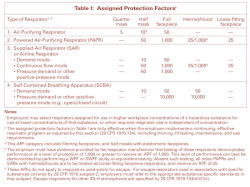Assigned Protection Factor
The level of protection provided by a respirator is indicated by the respirator's assigned protection factor (APF).
This number, which is determined experimentally by measuring facepiece seal and exhalation valve leakage, indicates the relative difference in concentrations of substances outside and inside the facepiece maintained by the respirator.
For example, the protection factor for full-facepiece air-purifying respirators is 50. This means, theoretically, workers wearing these respirators should be protected in atmospheres containing chemicals at concentrations which are up to 50 times higher than the appropriate limits.
You can also find more information on APFs in OSHA Publication 3352, Assigned Protection Factors.
TLVs, PELs, and RELs
At sites where the identity and concentration of chemicals in the air are known, a respirator should be selected with a protection factor sufficiently high to ensure the wearer will not be exposed to the chemicals above the applicable limits. These limits include:
- American Conference of Governmental Industrial Hygienists' Threshold Limit Values (TLVs),
- OSHA's Permissible Exposure Limits (PELs), and
- NIOSH Recommended Exposure Limits (RELs).
These limits are designed to protect most workers who may be exposed to chemicals day after day throughout their working life. The OSHA PELs are legally enforceable exposure limits and are the minimum limits of protection that must be met.
Compromising Protection
Remember, the protection provided by a respirator can be compromised in several situations, most notably:
- if a worker has a high breathing rate,
- if the ambient temperature is high or low, or
- if the worker has a poor facepiece-to-face seal.
At high breathing rates, positive-pressure SCBAs and SARs may not maintain positive pressure for brief periods during peak inhalation. Also, at high work rates, exhalation valves may leak. Consequently, positive-pressure respirators working at high flow rates may offer less protection than when working at normal rates.
A similar reduction in protection may result from high or low ambient temperatures. For example, at high temperatures, excessive sweat may cause a break in the face-to-facepiece seal. At very low temperatures, the exhalation valve and regulator may become ice-clogged due to moisture in the breath and air.
Likewise, a poor facepiece seal - due to such factors as facial hair, missing teeth, scars, lack of or improper fit testing, etc. - can result in the penetration of air contaminants.
Knowledge Check Choose the best answer for the question.
1-6. How can the protection provided by a respirator be compromised?
You forgot to answer the question!

